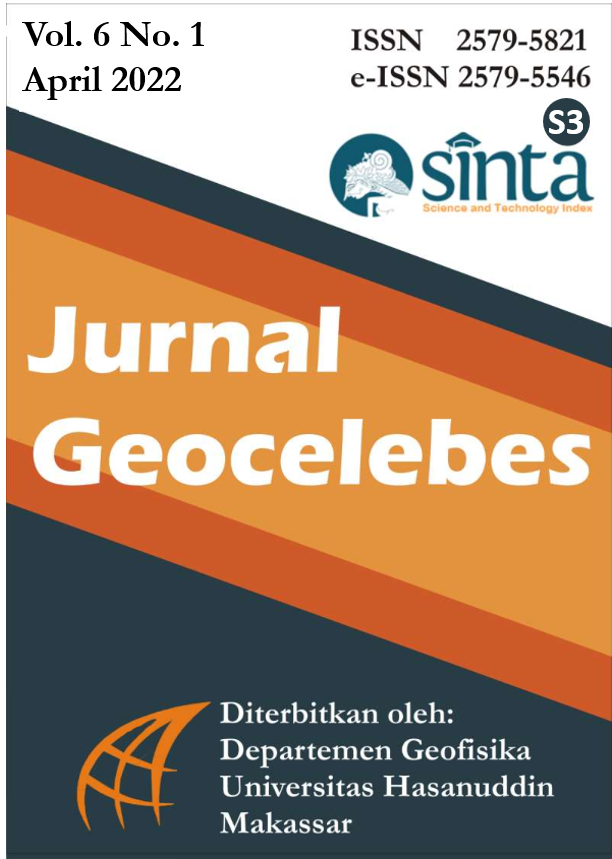Identification of Alteration-Mineralization in Skarn Deposit System based on Time-Domain Induced Polarization Method Approach in Kasihan Area, Pacitan, East Java
Identifikasi Alterasi-Mineralisasi pada Sistem Endapan Skarn Berbasis Pendekatan Metode Time Domain Induced Polarization di Daerah Kasihan, Pacitan, Jawa Timur
DOI:
https://doi.org/10.20956/geocelebes.v6i1.17558Keywords:
chargeability, Dipole-Dipole, resistivity, Time Domain Induced PolarizationAbstract
This research was conducted in Kasihan, Pacitan, East Java with the aim of knowing the alteration zone and ore mineralization from mineral sediment systems based on the conductivity and resistivity of subsurface rocks in the study area. A geophysical method is needed to map area area area of the prospect of mineral deposits as well as mathematical models in the area research. One of the geophysical methods used in studies of mineral sediment cases is Time Domain Induced Polarization (TDIP). Measurement of Time Domain Induced Polarization method done with configuration dipole-dipole which is arranged relatively straight northeast-southwest as much 2 tracks, with each track having the length of 260 m with an initial space of 20 m electrodes. Targets of the TDIP Method can describe subsurface conditions as far as 48 m. The position of mineralization in skarn deposits in the Time Domain Induced Polarization method at a depth of 25 m below the surface topography shown by high resistivity values >2000 Ωm and >500 msec chargeability in dacite and limestoneDownloads
References
Dentith, M. and Mudge, S.T. 2014. Geophysics for the Mineral Exploration Geoscientist. Cambridge: Cambridge University Press. https://doi.org/10.1017/CBO9781139024358
Edwards, L.S. 1977. A Modified Pseudosection for Resistivity and IP. Geophysics. 42, pp.1020-1036. https://doi.org/10.1190/1.1440762
Griffiths, D.H. and King, R.F. 1981. Applied Geophysics for Geologists and Engineers: The Elements of Geophysical Prospecting. 2nd ed. Pergamon Press. https://doi.org/10.1016/C2009-0-10955-8
Haldar, S.K. 2018. Mineral Exploration. 2nd ed. Elsevier Inc. https://doi.org/10.1016/C2017-0-00902-3
Kearey, P., Brooks, M. and Hill, I. 2002. An Introduction to Geophysical Exploration. 3rd ed. ix 262 pp. Oxford: Blackwell Science.
Lindgren, W. 1928. Mineral Deposits. 3rd ed. London-New York: McGraw-Hill Publishing Co., Ltd. pp. xx+1049, with 317 figs.
Loke, M.H. 2004. 2D and 3D Electrical Imaging Survey. United Kingdom: Birmingham University. https://sites.ualberta.ca/~unsworth/UA-classes/223/loke_course_notes.pdf
Meinert, L.D. 1993. Igneous petrogenesis and skarn deposits. Geological Association of Canada - Special Paper. 40, pp.569-583. https://www.researchgate.net/publication/279618611_Igneous_petrogenesis_and_skarn_deposits
Misra, K.C. 2000. Understanding Mineral Deposits. Knoxville: Springer- Science+Business Media, B.V. https://doi.org/10.1007/978-94-011-3925-0
Pirajno, F. 2009. Hydrothermal Processes and Mineral Systems. Netherlands: Springer Science+Business Media B.V. https://link.springer.com/book/10.1007/978-1-4020-8613-7
Prihatmoko, S., Digdowirogo, S. and Kusumanto, D. 2002. Potensi Cebakan Mineral di Jawa Tengah dan Daerah Istimewa Yogyakarta. In: Prosiding Seminar Geologi Jawa Tengah dan Daerah Istimewa Yogyakarta, Ikatan Ahli Geologi Indonesia Pengda Yogyakarta, p. 87-108.
Reynold, J.M. 2011. An Introduction to Applied and Enviromental Geophysics. United Kingdom: Wiley-Blackwell.
Ridley, J. 2013. Ore Deposit Geology. New York: Cambridge University Press. https://doi.org/10.1017/CBO9781139135528
Sumner, J.S. 1976. Principles of Induced Polarization for Geophysical Exploration. 1st ed. Amsterdam: Elsevier.
Tun, M.M., 2007. An Investigation of Geology and Mineralization in the Kasihan Daerah, Pacitan Regency, East Java, Indonesia. Master Thesis, Universitas Gadjah Mada.
White, N.C. and Hedenquist, J.W. 1995. Epithermal Gold Deposits: Styles, Characteristics and Exploration. SEG Discovery. 23, pp.1–13. https://doi.org/10.5382/SEGnews.1995-23.fea
Downloads
Published
How to Cite
Issue
Section
License
Authors who publish with this journal agree to the following terms:
- Authors retain copyright and grant the journal right of first publication with the work simultaneously licensed under a Creative Commons Attribution License that allows others to share the work with an acknowledgement of the work's authorship and initial publication in this journal.
- Authors are able to enter into separate, additional contractual arrangements for the non-exclusive distribution of the journal's published version of the work (e.g., post it to an institutional repository or publish it in a book), with an acknowledgement of its initial publication in this journal.
- Authors are permitted and encouraged to post their work online (e.g., in institutional repositories or on their website) prior to and during the submission process, as it can lead to productive exchanges, as well as earlier and greater citation of published work (See The Effect of Open Access).



